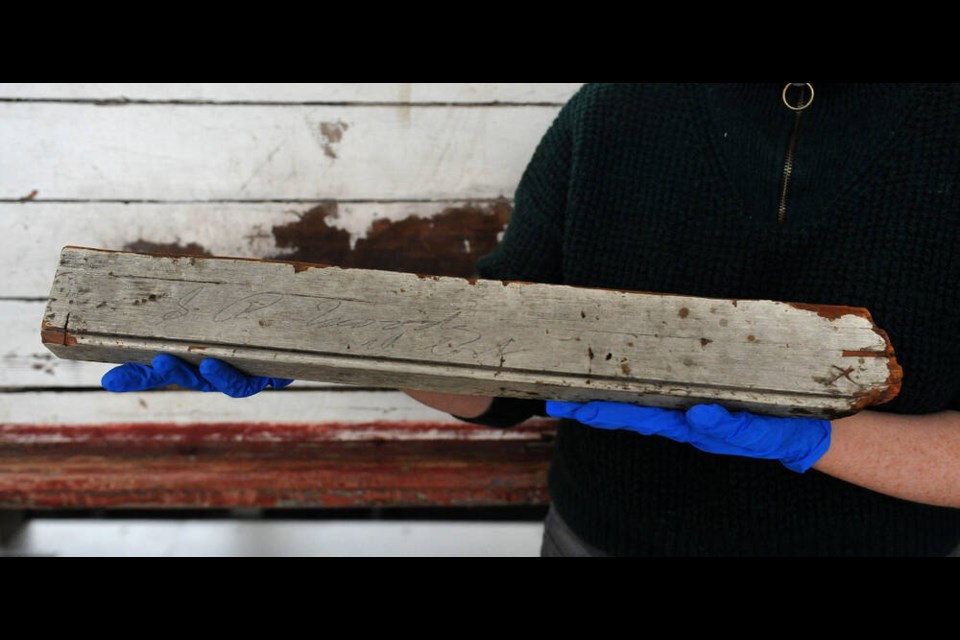VANCOUVER — On a cold night in November 1875, Sewell Moody stood onboard the doomed sidewheeler Pacific, realizing that a glancing collision with a sailing vessel an hour earlier, on the western edge of the Juan de Fuca Strait, had been fatal.
The 41-year-old businessman had established the first sawmill on the north shore of Burrard Inlet on Tsleil-Waututh lands and had made a lot of money since arriving in New Westminster in 1861 from the U.S.
He was headed from Victoria to San Francisco to buy another sawmill that he planned to establish in Squamish.
But on this night, no measure of wealth would protect him or the other roughly 350 souls onboard the wooden ship from becoming statistics in the Pacific Northwest’s worst maritime disaster.
At some point, before the ship broke up and its lifeboats were rendered useless, Moody had the wherewithal to take a piece of white-painted board from a stateroom stanchion or support frame and write upon it in lead pencil his signature and the message “All Lost.”
Six weeks later, that board washed up on the beach just below Beacon Hill near Victoria, close to where Moody had been living at the time, and was found by government workers still checking the beaches daily for bodies from the wreck.
The signature was verified by Moody’s wife and the board kept in the family until the 1960s, when it was given to the Vancouver Maritime Museum by one of Moody’s granddaughters.
This nearly forgotten piece of B.C. maritime history is now front and centre with the news last month that the wreck of the Pacific had been found and that it likely contains millions of dollars worth of gold from the Cassiar Gold Rush.
The U.S.-based consortium that located the Pacific — Rockfish Inc. — filed papers in the U.S. District Court in Seattle in November stating the wreck was at a depth of around 500 metres off Cape Flattery on the tip of the Olympic Peninsula.
Rockfish has been granted salvage rights and plans to recover as many artifacts and items of value as possible and use that collection as the base for a museum and hotel in Puget Sound. The development will ultimately repay the salvage costs.
Rockfish founder Jeff Hummel said the wreck was remarkably well preserved because when it hit the ocean floor the clay and mud rose up and then fell back down on the wreck — effectively sealing it.
The company is having built in Mexico a 75-by-30 metre structure that will be placed around the wreck as a base for the salvage effort. Underwater robotic equipment will then be used to move aside the clay cover and start extracting artifacts.
“We will find precious cargo on board,” Hummel said.
At the time of the sinking, there was an estimated 4,000 ounces of gold on board, now worth about $10 million, most likely in the form of assayed gold bullion. The ship was reported to be carrying at least one iron and wooden locked box owned by Wells Fargo Bank that contained gold.
A historical paper written about the sinking states the ship was carrying “prominent Victorians, wealthy businessmen, numerous gold miners, an equestrian troupe, and 41 Chinese labourers.
“In addition, the Pacific’s hold was laden with 2,000 sacks of oats, 300 bales of hops, 261 animal hides, 11 casks of furs, 31 barrels of cranberries, 10 cords of wood bolts, 280 tons of coal, 18 tons of general merchandise, 10 tons of sundries, six horses, two buggies, two cases of opium, and a strongbox containing $79,200 in cash. The gold in private hands was estimated to be at least $100,000.”
Hummel said the vessel was also carrying all of the photographic plates from survey work done by Canadian Pacific Railway before building its cross-Canada rail line.
“We will find those plates,” he said. “As well as clothing and leather. We expect to find wine with the corks still in them.”
Hummel is working on the project with the Northwest Shipwreck Alliance, which plans to start recovering artifacts in the fall of 2023 and the summers of 2024 and 2025.

